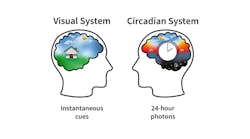However, there is still one measure that is missing: the rated life for LED light sources. Rated life is an essential reliability property for LED integrators that design LED luminaires, providing luminaire users with warranty and usage information
Rated life
The rated life of a lamp or light source is defined, per ANSI/IES RP-16, as “the life value assigned to a particular type lamp. This is commonly a statistically-determined estimate of median operational life.” The rated life in hours of an LED lamp or light source, specified by the manufacturer, applies under certain operational conditions and for defined failure criteria. The statistical measure for the rated life is designated Bp and is measured in hours, where p is a percentage.
For example, a B50 rated life of 1,000 hours means that 50% of the tested products have lasted 1,000 hours without failure. B50 is also known as the products’ rated average life.
If a product has a B10 rated life of 1,000 hours, this means that only 10% of tested products failed within 1,000 hours, so the product should last much longer than a product with a B50 rated life of 1,000 hours.
Lumen-maintenance life
For LED light sources, LM-80 defines lumen-maintenance life as “the elapsed operating time at which the specified percentage of the lumen depreciation or lumen maintenance is reached, expressed in hours.” Different from rated life, the rated lumen-maintenance life is defined as “the elapsed operating time over which an LED light source will maintain the percentage (p) of its initial light output.”
Rated lumen-maintenance life is measured in hours with associated percentage of light output, noted as Lp. In other words, L70 of 30,000 hours means that the tested LEDs produce 70% of the initial light output at 30,000 hours. If an LED has L50 of 30,000 hours, its lumen output decays faster than one with L70 of 30,000 hours.
While Bp life is a statistical measure, Lp life is a defined durability measure. When testing for Bp life, a large statistically-meaningful sample size is required. When testing Lp life, there is no sample size requirement. However, when LM-80 test data is utilized to make lumen-maintenance projections (per TM-21), the sample size will affect the uncertainty of the projection. As a consequence, a smaller sample size will lead to shorter projected life in order to increase the statistical certainty.
Failure
For LED light sources, one can define failure as when the LED can no longer produce a certain percentage of the initial light-output value. For example, failure might be defined as when the light output of an LED reaches 70% or lower of the initial light output (including if the LED’s light output is zero). In other words, for a given period of time, if an LED produces insufficient light or no light, the LED is considered at failure.
Using this definition of failure criteria, the statistical measure can be combined with the defined durability measure. The combination of lumen-maintenance life (Lp) with statistically-measured failures (Bp) is the LED light source’s rated life, or BpLp value. For example, if an LED light source is claimed to have B50L70 of 30,000 hours, then 50% of tested samples should have a lumen-maintenance life of 30,000 hours.
Ideally, to obtain the rated life for LEDs, the statistical failure measurement can be integrated with lumen-maintenance measurements during the life test. One can use a large LED sample size, large enough to be statistically meaningful as when measuring traditional lamps, and then track and record the sample behaviors including light-output change and failures during the life test. When 50% of the tested samples reach a light output equal to 70% of initial lumens, including the samples that failed to produce light, then B50L70 (in hours) is obtained.
Obviously, as is the case with lumen maintenance, it is not practical to conduct real-life tests to get B50L70 values when such a value can be as long as 30,000 hours, or nearly three and a half years. The challenge is how to make a projection using the data obtained in a shorter testing period.
Projections
LED manufacturers have been conducting studies and establishing practices for reliable approaches to project the rated life for LEDs; in general, there are two approaches.
The first approach is to conduct LM-80 testing with a large sample size. The test data are collected for both light-output changes and failures. The data is then fitted into a mathematical model with a statistical-certainty band. In addition to the lumen-maintenance projection curve, the associated sample distribution bandwidth is also plotted. By analyzing the curve and bandwidth, an estimated B50L70 life is projected.
The second approach is to conduct the lumen-maintenance (LM-80) test separately from the accelerated-failure-modes test. Using TM-21, the lumen-maintenance projection can be established. The data collected in the accelerated-failure-modes test are modeled with a different mathematical expression. The rated life is then projected by mathematically combining both models.
There are some discussions in standardization organizations regarding development of a document or recommendation to address LEDs’ rated life. To help the LED lighting industry to properly use LED light-source information, it is necessary to clarify that rated life is not lumen-maintenance life.
Before the industry establishes a recommendation for a standard practice, LED integrators may need to request more testing and modeling information from the manufacturers in regards to the statistical failures of LED light sources.




